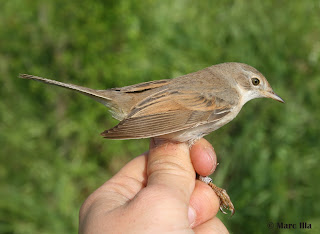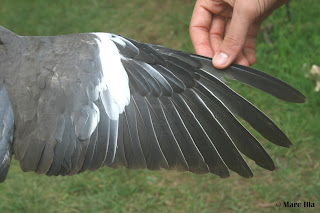One of my favourite birds this spring was this cracking adult (EURING 6) male Blue Rock Thrush (Monticola solitarius). Indeed, I had never ringed this species, and it was quite on the top of my 'wish list'...
 |
| Adult (EURING 6) male |
I've been quite lucky with Hoopoes (Upupa epops) this year. For instance, this retuning bird in my ringing place was very nice: retraps are very interesting in many terms, such the condition as 'proven age' individuals.


 |
| Adult (EURING 6), ringed as a 2cy (EURING 5) in 2015. |
 |
| Female (left) and male (right). Compare the color on breast, throat and face. |
During a few days I visited Aiguamolls de l'Empordà Natural Park, on the right top corner of Catalunya, where a spring ringing campaign is working for the last few years. Check this link to see this year's numbers!
The campaign had the best season this year, and I really enjoyed the couple of days I spend there, with some interesting stuff...
 |
| Adult, 4+, (EURING 8) Woodpigeon (Columba palumbus). Check the retained secondaries, with adult-type pattern. |
 |
| Little Bitterns (Ixobrychus minutus) are also very interesting and nice, I'll leave ageing comments for another day ;). Keep in mind that sometimes they are a bit agressive... |
 |
| Common Starlings (Sturnus vulgaris) are even worse to handle, not because they are dangerous, but they can turn a bit disgusting while screaming... Anyway, they are gorgeous! |
Matà marshes were very nice, filled up with birds!
 |
| Flamingo (Phoenicopterus roseus) |
 |
| A quite late male Pintail (Anas acuta) |

Stephen's visit was quick, and you'll find more stuff we did in his blogpost, but if I have to say something to resume it I guess it will be the Quail-catching afternoon. Indeed, I've been ringing some Quails (Coturnix coturnix) this year, but they will be kept for another blogpost, either mine of Stephen's... :)

Another thing I want to emphasize was Stephen's reflexion of the richness of birds here, compared to London countryside. Indeed, I have been thinking quite a lot about this... everywhere has it's very important value, even the most unknown or 'crappy' habitats in terms of numbers and diversity. The actual importance of local environmental protection areas is sometimes forgotten... so that's why, even living in a rather poor countryside in terms of birding, were the rare birds are not even national raritees, I am very proud of studying and doing my best to protect my area.
Related to these short thoughts, I had a very nice ringing day in my local patch, that was full of migrants! Again, we are not talking about the Ebre Delta, it's just a small wetland in the middle of very dry fields. Some captures were...
 |
| Whinchats (Saxicola rubetra) like fences between agricultural areas, and there's where I trap them with spring traps. |
 |
| Reed Warbler (Acrocephalus scirpaceus), the commonest transaharan passerine so far in the area. This one had an Italian ring!! |
 |
| Melodious Warblers (Hippolais polyglotta) are common in the area. Remember some have quite obvious white panels on wing, resembling Icterine in the field...! |
 |
| Common Whitethroat (Sylvia communis) |
 |
| Garden Warbler (Sylvia borin) |
 |
| Female (above) and male (below) Western Subalpine Warblers (Sylvia cantillans iberiae). |
 |
| Pied Flycatcher (Ficedula hypoleuca) |
 |
| Common Nightingale (Luscinia megarhynchos), very common in the area. This bird was ringed in 2012! Nightingale is so far the species with more recoveries year to year. |
 |
| Grasshopper Warbler (Locustella naevia), very scarce migrant in my place! |

 |
| Adult (EURING 6) Western Orphean Warbler (Sylvia hortensis), only the second record in my area. Although some breeding pairs can be found rather nearby, it is very difficult to see them as migrants. |
For the last few years, some Black Redstart (Phoenicurus ochruros) pairs have arrived in villages and towns in drylands, quite far from the mountains. I was listening to a male every morning singing from my roof, so I decided to catch it. It was particularly easy, it took less than 2 minutes with tape and a clap net; and it turned to be a very interesting individual. In fact, it could be sexed safely as a male (since it had a very well developed cloaca), but it was a second-year (EURING 5) with no 'male plumage features' at all. An actual 'cairii'... Check this post about 'paradoxus' Black Redstart for more information about things matter.






No comments:
Post a Comment